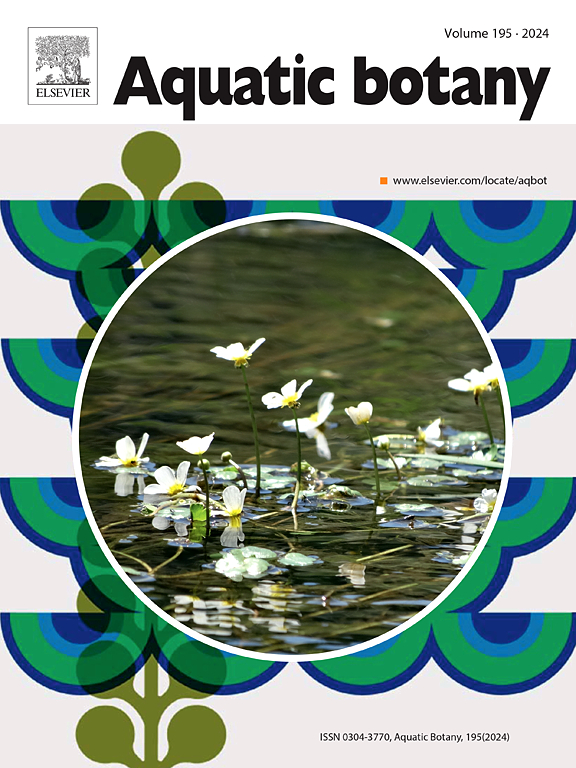Hydrological suitability for mangrove species in restored mangroves in abandoned ponds
IF 2.6
4区 生物学
Q2 MARINE & FRESHWATER BIOLOGY
引用次数: 0
Abstract
Mangrove restoration projects in Indonesia are widely conducted in abandoned aquaculture ponds, however the success of planting mangroves is limited as tidal flooding is often not considered. The hydrology of mangrove surrounding water is both complex and dynamic and creates tide-induced flow and mangrove vegetation interaction that influences hydrological suitability of mangrove species. In this study, we aimed to determine the hydrological suitability for specific mangrove species in mangrove restoration efforts in abandoned aquaculture ponds by measuring tidal inundation duration in mangrove waters. The study was undertaken in two restored mangroves sites in abandoned ponds in Perancak estuary, Bali and Lubuk Kertang, North Sumatra, which was combined with measurements of intact mangroves for comparison. Tidal flooding (inundation and current velocity) was recorded to obtain flooding period measurements (depth, duration and tidal velocity) in association with mangrove succession rates. We found that the variability of tidal flooding between study sites was found to determine dominant mangrove species, suggesting a mangrove species-specific tolerance to tidal flooding in establishing habitats. Among the species observed, Nypa fruticans was found to be the most resilient to prolonged tidal inundations. Rhizophora spp., Avicennia spp., Sonneratia alba, however, adapted to a wider range of inundation periods. The tidal inundation in restored mangrove ponds was characterized by low current velocities, which provides suitable conditions for mangrove recovery in restoration sites. This information on hydrological classification proves that the effectiveness of mangrove restoration projects can be improved by highlighting the necessity to account for localized tidal inundation regimes.
废弃池塘中恢复红树林物种的水文适宜性
印度尼西亚的红树林恢复项目广泛在废弃的水产养殖池塘中进行,但由于通常不考虑潮汐洪水,种植红树林的成功有限。红树林周围水域的水文是复杂和动态的,并产生潮汐诱导流和红树林植被相互作用,影响红树林物种的水文适宜性。在这项研究中,我们旨在通过测量红树林水域的潮汐淹没时间来确定废弃水产养殖池塘红树林恢复工作中特定红树林物种的水文适宜性。这项研究是在巴厘岛Perancak河口和北苏门答腊岛Lubuk Kertang的两个废弃池塘中恢复的红树林地点进行的,并将其与完整红树林的测量结果相结合进行比较。潮汐洪水(淹没和流速)被记录下来,以获得与红树林演替率相关的洪水期测量(深度、持续时间和潮汐速度)。我们发现潮汐洪水在不同研究地点之间的可变性决定了红树林的优势物种,这表明红树林在建立栖息地时对潮汐洪水具有特定的耐受性。在观察到的物种中,发现果蝠对长时间的潮汐淹没最具弹性。而根霉属、海棠属、海桑属则能适应更大范围的淹没期。恢复后的红树林池塘潮汐淹没具有低流速的特点,为恢复地红树林的恢复提供了适宜的条件。有关水文分类的资料证明,通过强调考虑局部潮汐淹没情况的必要性,可以提高红树林恢复项目的有效性。
本文章由计算机程序翻译,如有差异,请以英文原文为准。
求助全文
约1分钟内获得全文
求助全文
来源期刊

Aquatic Botany
生物-海洋与淡水生物学
CiteScore
3.80
自引率
5.60%
发文量
70
审稿时长
6 months
期刊介绍:
Aquatic Botany offers a platform for papers relevant to a broad international readership on fundamental and applied aspects of marine and freshwater macroscopic plants in a context of ecology or environmental biology. This includes molecular, biochemical and physiological aspects of macroscopic aquatic plants as well as the classification, structure, function, dynamics and ecological interactions in plant-dominated aquatic communities and ecosystems. It is an outlet for papers dealing with research on the consequences of disturbance and stressors (e.g. environmental fluctuations and climate change, pollution, grazing and pathogens), use and management of aquatic plants (plant production and decomposition, commercial harvest, plant control) and the conservation of aquatic plant communities (breeding, transplantation and restoration). Specialized publications on certain rare taxa or papers on aquatic macroscopic plants from under-represented regions in the world can also find their place, subject to editor evaluation. Studies on fungi or microalgae will remain outside the scope of Aquatic Botany.
 求助内容:
求助内容: 应助结果提醒方式:
应助结果提醒方式:


